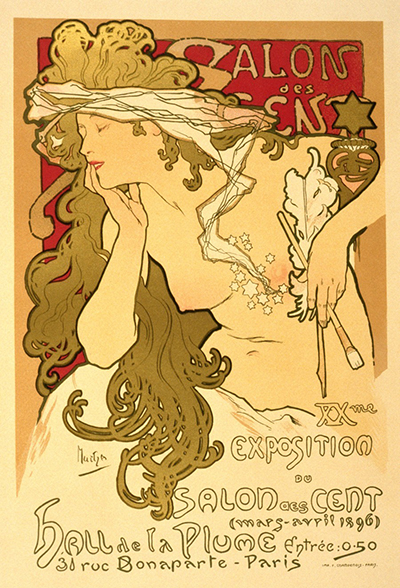Salon des Cent provides another opportunity for Alphonse Mucha to display his impressive illustrative skills and particularly his brilliance with portraiture. Here we find a female figure dominating a relatively simple scene, with the title of the piece written over her left shoulder.
There is not such the same level of detail as we find elsewhere in his posters, with a relatively subdued background devoid of the patterns found in other examples such as Job, Amants and Bieres de la Meuse. The lady used here is depicted scantily-clad, with just a white headband for her modesty. In other cases Mucha would introduce swirling, stunning dresses that would be elongated for artistic effect. One careful study of this composition, we actually find that this woman is an artist of sorts, or at least is being used to symbolise that pastime. She holds a paintbrush in her left hand, and so perhaps her headband is similar to how some artists will tie their hair back when working for the purpose of keeping tidy. One part of extravagance within the depiction would have to be her hair, which hangs down under her left arm and curls away at the ends, with a beautiful flourish around which the text is then carefully placed.
The text at the bottom of the design reads Hall de la Plume, signifying the location of the event being advertised, and that it resides in Rue Bonaparte in Paris, which one can immediately presume to be a particularly significant street within this famous and highly cultural French city. Entrance fees are also indicated, along with the date and another confirmation of the title of the event, Salon des Cent. The artist then leaves a small signature just to the side of where the model's hair finishes, just as he did in all of his illustrative posters in order to help build his own brand and potentially find new patrons. The bottom part of the design is deliberately filled in a neutral tone of white without any form of blending of gradation in order to allow the lettering to remain clear, even though the words are not filled with any alternative colour and therefore rely entirely on the carefully crafted outlines of each letter.
A related artwork to this would have to be Salon of the Hundred although the artist himself produced a huge selection of posters during the late 19th and early 20th century as his reputation spread quickly, particularly within the commercial and theatrical industries of Paris. Later on he would start to receive commissions from elsewhere in Europe too, even eventually from the US after a short visit there. The theatre scene was particularly successful during this era and Mucha's own style seemed entirely appropriate to advertising various shows and there was enough wealth around to be able to afford this artist's services in promoting it. Although he lived most of his life as a commercial artist, merely seeking new work to help finance his life, Mucha would later establish himself as one of the most famous illustrators in art history, competing with the likes of Aubrey Beardsley from the UK and a number of others at around this time.




